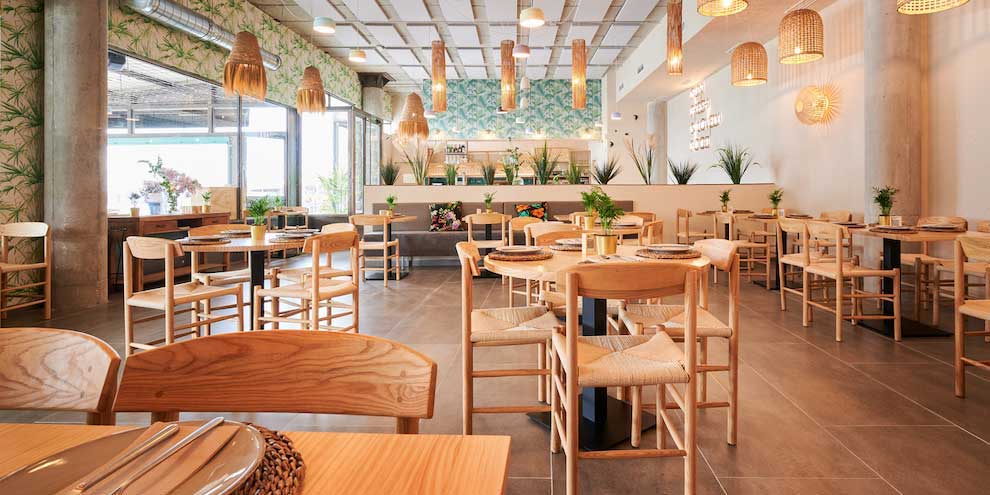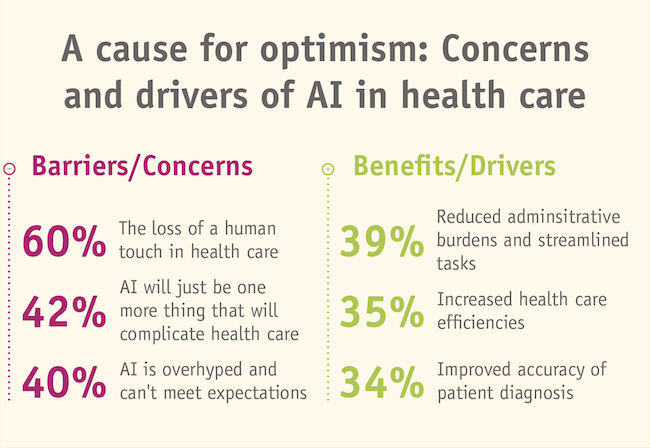••• shopper research
Buffeted by change
Checking in with grocery shoppers, diners

Self-checkout continues to gain traction, with 43% percent of consumers expressing a preference for it over traditional checkout. Digital commerce solutions company NCR Voyix found that 53% of younger shoppers (ages 18-44) prefer self-checkout. Of those consumers who prefer self-checkout, speed, shorter lines and privacy are most important. Shoppers aged 45-60+ prefer traditional checkout but the top reason behind their choice is that they often have many products and find a regular lane less time-consuming.
While online grocery shopping may be more convenient for those who don’t have time to shop in person, two-thirds of survey respondents prefer to shop for groceries in store. Challenges like out-of-stock items (62%), incorrect deliveries (52%) or unfulfilled orders (38%) contribute to poor online ordering experiences. Nearly two-in-five survey respondents (37%) indicate having abandoned an online order due to high service fees. Some consumers also prefer to hand-select specific items like produce (59%), meat (51%), dairy (40%), frozen foods (29%) and bakery items (42%) themselves.
With inflation driving higher grocery prices, 74% of consumers surveyed have changed how they shop for groceries. Most are looking for less-expensive items (56%), buying less overall (49%), making a more deliberate decision to shop where they find the best deals (46%), using digital coupons more often (26%) and 22% are joining store loyalty programs to save money.
Consumers increasingly rely on technology to navigate smarter ways to shop. When asked how technology has changed their shopping experiences, consumers cited the ability to compare prices more frequently, research products before purchasing more frequently and use more digital payment options.
In the restaurant industry, consumers want the best customer service – but the surge in tipping prompts may be tipping them the wrong way. Fifty-nine percent of consumers reported that they don’t like tipping prompts. Out of those, 61% say they don’t tip while 39% indicate that they still do.
Like grocery shopping, inflation has impacted consumer restaurant dining habits. Forty-eight percent say they dine out less now because of higher prices and 27% say they dine out the same amount. More than half of consumers (58%) have purchased a meal at a gas station one or more times this year.
Although some consumers may be slowing down on traditional dining out, they still want to keep up with their favorite restaurants and access any deals they can. Signing up for a loyalty rewards program (49%), downloading a restaurant’s app (49%) and signing up for e-mail updates (31%) are among the top three actions consumers have taken to receive updates on their favorite restaurants.
With consumers eager to stay in the know and gain access to special deals and rewards, half of them prefer to use a restaurant’s app or website to place their order, while 23% prefer to call the restaurant directly. Consumers cite their top reasons for going directly to the restaurant’s app or website for order and delivery as convenience, the ability to easily customize orders and lower or no service fees.
As consumers look to the future and consider new technology in restaurants, they hope to see customized digital menus personalized per diner, full meal vending machines and robot delivery service.
NCR Voyix commissioned a survey of 1,133 American consumers in November 2023.
••• environmental research
Greener options wanted
Consumers demand eco accountability
Recently, a range of societal issues have moved to the forefront of consumers’ minds but one thing remains a clear influence over spending behavior: sustainability. According to GfK Consumer Life, more than half the U.S. population (53%) expressed serious concern for the environment, noting it should be a priority for everyone. Sixty-seven percent also agree that environmental pollution is a serious issue, up three percentage points from 2022. Events like the pandemic have prompted consumers to connect with the environment in more personal ways, placing a heightened emphasis on conservation.
While inflation is the No. 1 societal concern for consumers today, global climate change ranks No. 6 out of 24 – on par with issues like recessions and the cost of health care. As a result, Americans are noticing the impacts of climate change. Seventy-seven percent of consumers agree that extreme weather is increasing because of climate change and just one-in-three believe the government is doing an excellent or good job addressing the issue. Consumers expect companies to step up too, with 67% agreeing that it is important for companies to take environmentally responsible actions.

Though concern is growing, many consumers grapple with barriers to living a sustainable life. There’s an issue with the perception of high prices and lower quality when it comes to “green” products, with 55% of Americans saying environmentally friendly products are too costly (up four points since 2021). Additionally, only 29% of consumers consider the environment when purchasing, down three points from 2022. The impact of ongoing inflationary pressure is prompting consumers to reconsider where they spend their precious dollars. However, consumers play a balancing act during these moments of reduced spending: They turn to the home for their eco-friendly actions.

Sixty-seven percent of consumers will conserve energy in the home through actions like turning off lights, monitoring cooling and heating devices and using major appliances less frequently. These actions serve a double purpose, serving as financial savings in the face of economic uncertainty and an expression of sustainable values. Consumers want to do more – in fact, 80% want greener energy options to be more accessible.
With all this in mind, it’s important to look ahead at what consumers think the future of sustainability looks like, and that lies in circularity. Eighty percent agree that a waste-free lifestyle is possible in the next 20 years and a staggering 87% agree that it’s important for companies to source materials responsibly. From electronics to clothing, consumers are interested in extending the useful life of products and they expect companies to step up with them.
The 2023 Green Gauge study was conducted among approximately 35,000 consumers in 20+ core global markets, including 2,059 interviews in the U.S. from January-April 2023.
••• entertainment research
Tuning in
Americans de-stress with digital audio

In a nation defined by its diverse tastes and cultural shades, audio series platform Pocket FM found that 90% of users engage with audio entertainment daily, reflecting the influence of audio in their daily lives. Storytelling takes the spotlight, inspiring half of users to prefer audio, while one-third of users opt for audio due to its convenience and another third values it for the diverse range of content.
While consuming audio content, 63% of Americans favor smartphones, 15% opt for tablets and 22% spread their audio consumption across smart TVs, desktops and other devices. Genres such as drama (21%), romance (23%), suspense/thriller (16%) and sci-fi (15%) emerge as top choices.
Regarding content duration, 43% of U.S. listeners lean towards shorter episodes, spanning five to 15 minutes, while 38% prefer a slightly longer duration of 15-30 minutes. Only 18% are inclined toward lengthier content, opting for episodes lasting approximately 45-60 minutes.
Audio entices the imagination with 45% of respondents visualizing the storytelling while listening, while the remaining 55% lean toward a visual experience, desiring the audio storytelling to be adapted to media like movies, TV series or web series.
Trust in content recommendations emerged as a crucial factor, with 38% relying on platform recommendations, 31% seeking guidance from social media and, surprisingly, only 3% swayed by influencers.
The survey uncovered that audio serves not only as an entertainment source but also as a productive tool, with 65% of users leveraging audio to de-stress, 17% to avoid distraction and 17% to enhance focus, showcasing its versatility in meeting various user needs. Additionally, 62% of U.S. listeners are keen on recommending their favorite audio content. When it comes to spreading the word, good old-fashioned word of mouth leads the pack with 42% of users relying on recommendations from friends. Social media is a little behind, influencing 34% of users.
Zooming into specific audio content, audio series steal the spotlight, with 67% giving five-star recommendations. In comparison, 42% give five-star ratings to TV entertainment but get a rating of three or below from 37% users. Online music and video OTT also fare well, with 53% and 58% giving five-star ratings, respectively, but rated three or below by 29% and 20% of users, highlighting a shift in the audience's digital entertainment preferences and reflecting fatigue with the existing format.
While audio series emerged as the most loved and preferred entertainment format, the findings have shown that 36% of users shifted from music to audio series, 22% of users replaced audio series with video streaming and 18% moved from audiobooks and podcasts, illustrating the dynamic evolution of American entertainment preferences.
Twenty-nine percent of American users lean toward subscriptions, though 32% are more inclined to pay for individual episodes, signaling a potential shift in monetization strategies towards microtransactions. Meanwhile, 39% prefer ad-supported models and other promotional offerings.
The survey was conducted from October 28-November 15, 2023, with a total sample size of 4,394 internet users in the U.S.
••• health care research
Physicians growing weary
Worn out and seeking help from AI
Excessive administrative workloads, reduced staffing, concerns over financial viability and rising patient expectations around communications are all contributing to major challenges for America’s health care industry, athenahealth’s Physician Sentiment Survey, conducted by The Harris Poll, has revealed.
Most physicians (93%) surveyed say that they feel burned out on a regular basis, with doctors reporting that they spend an average of 15 hours per week working in “pajama time,” outside their normal work hours. When asked about their current employment situation, over half (56%) said they have considered leaving the field or remaining in the field but no longer seeing patients.

Eighty-three percent of survey respondents say AI could eventually reduce many of the problems health care is facing. Most physicians already use electronic health record solutions and praise them for helping provide high-quality care (65%) and improving efficiencies (54%).
Nearly all physicians (94%) agree that getting the right clinical data at the right time is very important, but most physicians (80%) don’t believe that more clinical data is always the answer to achieving higher-quality care. The majority are currently so overburdened by information that it raises their stress levels (63%) and for many, this information overload is a growing cause of their regular burnout (30% vs. 24% in 2022).
Only 38% of physicians believe their organization/practice is on solid financial footing and fewer than half (45%) believe they have the resources and/or tools to deliver quality care. An additional indication of their financial vulnerability: over the past 12 months half (50%) felt they have been unable to provide quality care based on volume and cost, at least once a week or more frequently.
 Those who believe in the positive potential of AI are much more hopeful that the field of health care is headed in the right direction. They also felt less burned out on a regular basis than those who were pessimistic about AI’s positive role. Most respondents (60%) see the loss of human touch as their biggest concern regarding the use of AI, reinforcing the belief that the best use of AI in health care will be by creating efficiencies in administrative functions, improving diagnostic accuracy, data monitoring and other back-office tasks. Four in 10 physicians report being concerned that AI will just be one more thing that will complicate health care (42%) and that AI is being overhyped and cannot meet expectations (40%).
Those who believe in the positive potential of AI are much more hopeful that the field of health care is headed in the right direction. They also felt less burned out on a regular basis than those who were pessimistic about AI’s positive role. Most respondents (60%) see the loss of human touch as their biggest concern regarding the use of AI, reinforcing the belief that the best use of AI in health care will be by creating efficiencies in administrative functions, improving diagnostic accuracy, data monitoring and other back-office tasks. Four in 10 physicians report being concerned that AI will just be one more thing that will complicate health care (42%) and that AI is being overhyped and cannot meet expectations (40%).
This survey was conducted online in the U.S. by The Harris Poll on behalf of athenahealth from October 23-November 8, 2023, among 1,003 physicians.
••• beverage research
The perfect pick-me-up
Consumers ditch coffee shops for homemade brews

While coffee is known to provide a sometimes-necessary boost of energy and alertness, the caffeine high is not the No. 1 factor fueling coffee consumption. Drive Research’s online survey about coffee consumption and preferences found that for 83% of consumers, taste is the most influential reason they drink coffee. This reason tops others such as coffee giving them energy (67%), increasing their productivity (43%) and its perceived health benefits (29%).
Seventy-three percent of people drink coffee every day, 20% drink it at least once a week and only 2% drink it less than once a month. With popular coffee chains consistently raising their prices, many have taken to making coffee at home. Sixty-six percent of respondents say they make coffee at home every day with 19% making it a few times a week and 4% making it once a week.
With most people drinking coffee for the taste, it comes as no surprise that only 18% of people prefer to drink their coffee black – a 56% decrease from 2022. This suggests a notable change in growing preferences for coffee variations with added flavors such as milk/creamer (39%), sweetener (5%) or both (38%).
More specifically, both almond milk and oat milk are growing in popularity among coffee drinkers. Preferences for oat milk grew by 90% and preferences for almond milk grew by 71% since 2022. Furthermore, people love the taste of coffee so much that they consume it in other ways than their morning or afternoon pick-me-up. Over half of the respondents surveyed enjoy coffee cake (61%) and coffee ice cream (54%). Plus, we can't forget about espresso martinis which are adored by one-in-four people – a 79% increase from 2022. Big fans of the trendy cocktail are Millennials (36%) and Gen Z (33%).
Drive Research surveyed 1,325 individuals and ended its fieldwork in January 2024.
••• transportation research
The future of travel
Generations list priorities

Technology has the potential to enhance our travel experiences throughout the surface transportation ecosystem, as well as improve safety, reliability and equity. However, user attitudes – from uncertainty about AI to the importance of sustainability – underscore the need for planning. The MITRE-Harris Poll found that U.S. residents believe their transportation experience will improve in the next 10 years with 40% saying it will get better, compared to just 23% who believe it will get worse.
Of the improvements respondents want to see, safety (90%) tops the list, followed by lower costs (83%), improved data privacy (79%), increased predictability (78%) and environmental sustainability (77%).
However, priorities vary among generations. Baby Boomers (62%) rate safety as the highest priority for transportation improvements. Gen X (47%) cites cost as the top priority. For safety improvements, Millennials (22%) are most likely to say city driving should be the top priority, while Gen Z are most likely to say that walking (26%), trains (13%) and buses (13%) should be the top priority. Twenty-four percent of respondents say highway driving and 21% say city driving is the No. 1 priority for safety improvements.
Acceptance of artificial intelligence and automation will play a significant role in determining the future of transportation. Less than half of U.S. residents expect AI and automation to have a positive impact in the next 10 years, with nearly 30% saying the technology will be harmful.
Forty percent expect to use driverless cars, taxis, ridesharing vehicles and delivery vehicles in their lifetime, with nearly 60% expecting to use driverless taxis in urban areas. Respondents in rural areas and Baby Boomers are least likely to say their transportation experience will improve. Sixty percent of respondents expect to use hybrid or electric vehicles in their lifetime but just 12% already do.
MITRE-The Harris Poll conducted this online survey with 2,096 U.S. adults from October 10-12, 2023.
